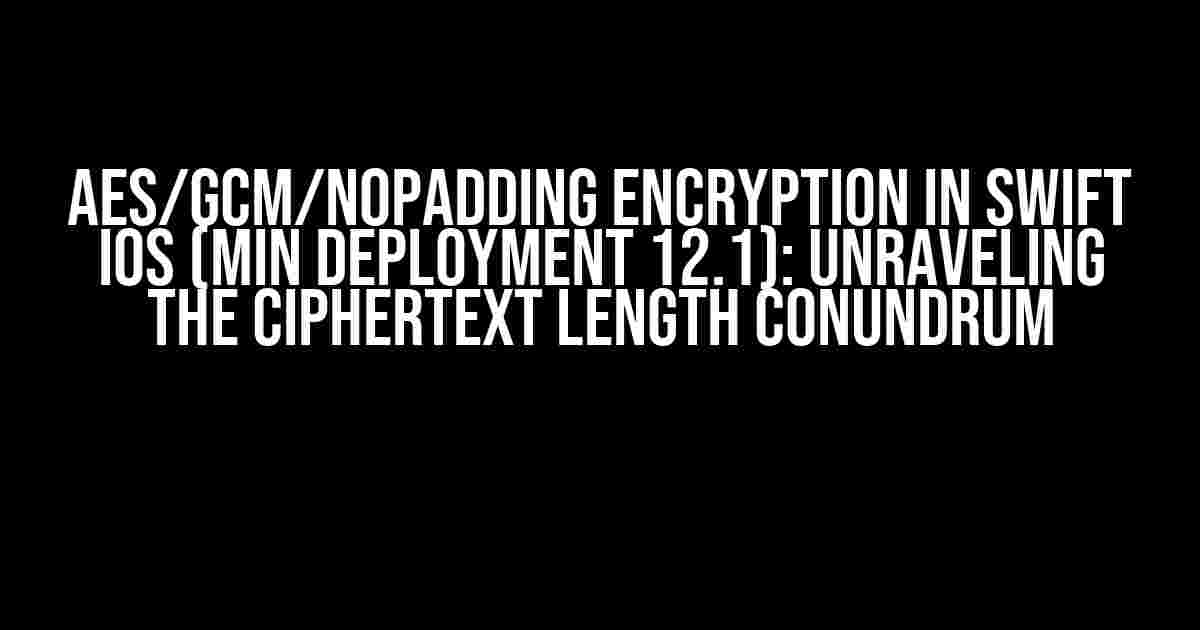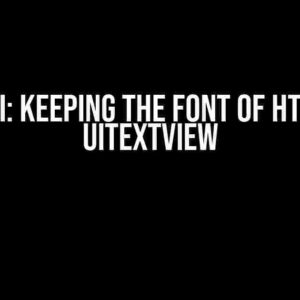Welcome, fellow developers! Are you struggling to get the expected ciphertext length when using AES/GCM/NoPadding encryption in your Swift iOS app? Don’t worry; you’re not alone. In this article, we’ll dive deep into the world of encryption and explore the reasons behind this anomaly. By the end of this journey, you’ll be well-equipped to tackle the issue and produce the correct ciphertext length for your encrypted data.
What is AES/GCM/NoPadding encryption?
AES (Advanced Encryption Standard) is a widely used encryption algorithm for securing data at rest and in transit. In Swift iOS, you can use the `AES` class from the `CryptoSwift` framework to encrypt your data. When combining AES with GCM (Galois/Counter Mode), you get a robust encryption scheme that provides both confidentiality and authentication. The `NoPadding` part of the equation means that the input data is not padded before encryption, which can be beneficial for certain use cases.
The Problem: Unexpected Ciphertext Length
When using AES/GCM/NoPadding encryption in your Swift iOS app, you might notice that the resulting ciphertext length is not what you expected. This can be frustrating, especially when working with sensitive data or tight storage constraints. So, what’s causing this anomaly?
The culprit behind this issue is the way AES/GCM encryption works. In GCM mode, the encryption process consists of two stages:
- Counter mode encryption, which produces a ciphertext of the same length as the input plaintext.
- Authentication, which appends a 128-bit authentication tag to the ciphertext.
The authentication tag, also known as the Galois Message Authentication Code (GMAC), is what alters the ciphertext length. This tag is essential for ensuring the integrity and authenticity of the encrypted data.
Why is the Ciphertext Length Important?
In many cases, the ciphertext length is crucial for correct data processing and storage. Here are a few scenarios where the unexpected ciphertext length can cause issues:
- Data Storage**: When storing encrypted data in a database or file system, a fixed or predictable ciphertext length is essential for efficient storage and retrieval.
- Data Transmission**: In networks with limited bandwidth or packet size constraints, an unexpected ciphertext length can lead to transmission errors or fragmented packets.
- API Integrations**: When integrating with APIs that expect a specific ciphertext length, an unexpected length can cause errors or failures.
Solving the Ciphertext Length Conundrum
To produce the expected ciphertext length, you need to account for the authentication tag appended during the GCM encryption process. Here’s a step-by-step guide to help you achieve the correct ciphertext length:
Step 1: Encrypt Your Data
import CryptoSwift
let plaintext = "Hello, Swift!".data(using: .utf8)!
let key = "your_secret_key_here".data(using: .utf8)!
let iv = "your_initialization_vector_here".data(using: .utf8)!
let encryptedData = try! AES(gcmKey: key,nonce: iv, authenticationTagLength: 128).encrypt(plaintext)
Step 2: Calculate the Authentication Tag Length
The authentication tag length, in this case, is 128 bits (16 bytes). You can calculate the expected ciphertext length by adding the authentication tag length to the input plaintext length:
let expectedCiphertextLength = plaintext.count + 16
Step 3: Extract the Authentication Tag
To get the correct ciphertext length, you need to extract the authentication tag from the encrypted data. You can do this by splitting the encrypted data into two parts: the ciphertext and the authentication tag:
let ciphertext = encryptedData.prefix(expectedCiphertextLength - 16)
let authenticationTag = encryptedData.suffix(16)
Step 4: Verify the Ciphertext Length
Now that you’ve extracted the authentication tag, you can verify that the ciphertext length matches your expected value:
assert(ciphertext.count == expectedCiphertextLength - 16)
Conclusion
In conclusion, the unexpected ciphertext length when using AES/GCM/NoPadding encryption in Swift iOS is due to the authentication tag appended during the encryption process. By accounting for this tag and following the steps outlined in this article, you can produce the correct ciphertext length for your encrypted data. Remember to calculate the expected ciphertext length, extract the authentication tag, and verify the resulting ciphertext length to ensure correct data processing and storage.
Troubleshooting Tips
- Double-check your key and IV**: Ensure that your encryption key and initialization vector are correct and match the requirements for AES/GCM encryption.
- Verify your input data**: Make sure your input plaintext is correctly formatted and padded (if necessary) before encryption.
- Debug your encryption process**: Use debug output or logging statements to inspect the encryption process and identify where the issue occurs.
| Encryption Scheme | Ciphertext Length |
|---|---|
| AES/GCM/NoPadding | Input plaintext length + 16 bytes (authentication tag) |
By following these guidelines and troubleshooting tips, you should be able to overcome the ciphertext length conundrum and ensure secure and efficient data encryption in your Swift iOS app.
If you have any further questions or need more assistance, feel free to ask in the comments section below!
Here are 5 Q&As about AES/GCM/NoPadding encryption in Swift iOS:
Frequently Asked Question
Get answers to your questions about AES/GCM/NoPadding encryption in Swift iOS
Why does AES/GCM/NoPadding encryption in Swift iOS not produce the expected ciphertext length?
This is because the GCM mode encryption scheme uses an authentication tag that is appended to the ciphertext. The tag is 128 bits (16 bytes) by default, which adds to the overall length of the ciphertext. Additionally, the IV (Initialization Vector) is usually prepended to the ciphertext, which adds another 12 bytes (96 bits) to the length. Therefore, the resulting ciphertext length is longer than the plaintext length.
How can I get the expected ciphertext length in AES/GCM/NoPadding encryption in Swift iOS?
To get the expected ciphertext length, you need to remove the authentication tag and IV from the ciphertext. You can do this by using the `-authenticate` method of the `AES` class in Swift, which returns the authentication tag, and then remove the IV from the ciphertext. Alternatively, you can use a library like `CryptoSwift` that provides a `gcmEncrypt` method that returns the ciphertext without the authentication tag and IV.
What is the minimum deployment target required for AES/GCM/NoPadding encryption in Swift iOS?
The minimum deployment target required for AES/GCM/NoPadding encryption in Swift iOS is iOS 12.1. This is because the `AES` class in Swift, which provides the `encrypt` method, was introduced in iOS 12.1.
Is AES/GCM/NoPadding encryption secure in Swift iOS?
Yes, AES/GCM/NoPadding encryption is secure in Swift iOS. The GCM mode encryption scheme provides both confidentiality and integrity of the data, and the AES encryption algorithm is widely considered to be secure. However, it’s important to note that the security of the encryption also depends on the quality of the random IV and key used, as well as the implementation of the encryption scheme.
Can I use AES/GCM/NoPadding encryption for large files in Swift iOS?
Yes, AES/GCM/NoPadding encryption can be used for large files in Swift iOS. However, it’s important to note that encrypting large files can be memory-intensive and may cause performance issues. It’s recommended to use a streaming encryption approach, where the file is encrypted in chunks, rather than loading the entire file into memory. Additionally, you may want to consider using a library like `CryptoSwift` that provides optimized encryption algorithms for large files.


